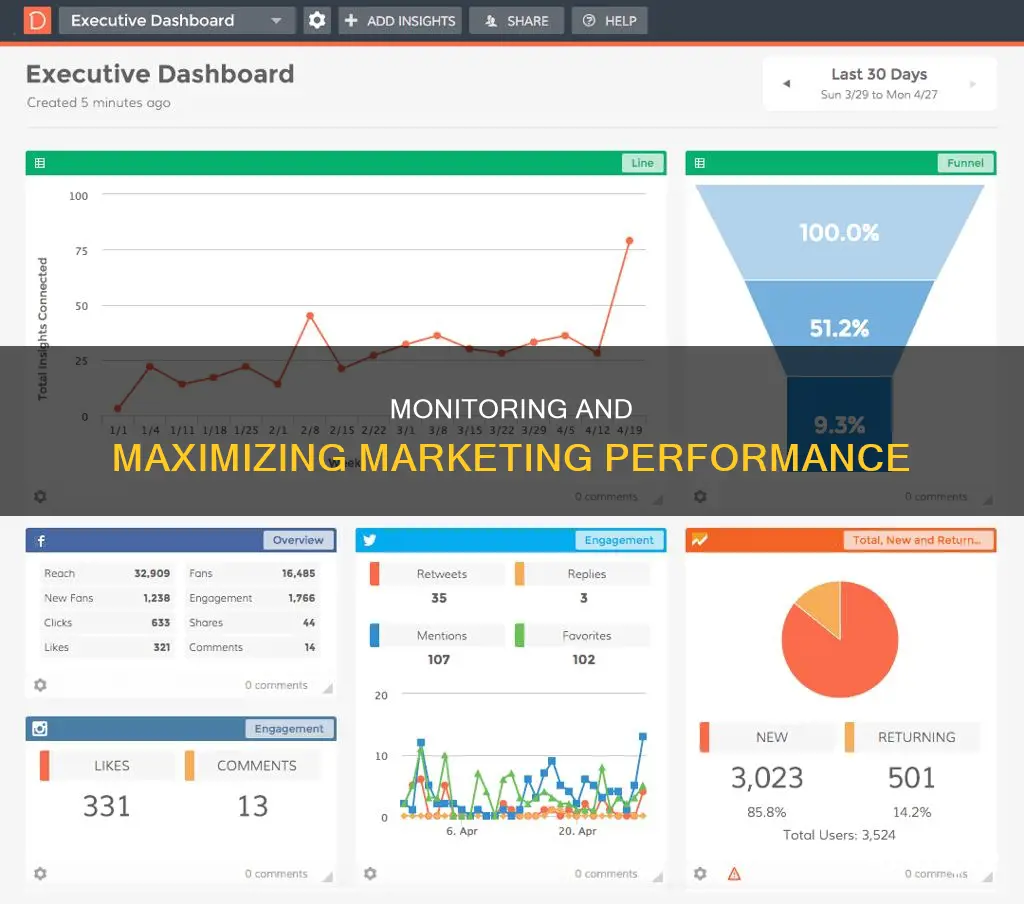
Monitoring and controlling marketing performance is an essential process for any marketing department. It helps them understand which campaigns are working, which channels are the most profitable, and how much each activity costs. It can also demonstrate the value of the marketing department's contributions to the company as a whole. To monitor and control marketing performance, it is important to set clear goals, choose the right tracking tools, establish key performance indicators (KPIs), and take actionable steps based on the data. This allows marketing teams to optimise their campaigns, allocate resources effectively, and improve their return on investment (ROI).
What You'll Learn

Set clear goals and KPIs
Setting clear goals and KPIs is an essential step in monitoring and controlling marketing performance. It provides a framework for evaluating the effectiveness of marketing campaigns and ensures that efforts are aligned with broader business objectives. Here are some key considerations for setting clear goals and KPIs:
Define Specific and Measurable Goals
Begin by setting specific goals that are well-defined and focused. Avoid vague goals like "gain new leads" and opt for more specific targets such as "increase the number of leads gained per month to 100 by the end of the quarter." Specific goals provide a clear direction and make it easier to measure progress.
Apply the SMART Framework
When setting goals, use the SMART framework:
- Specific: Ensure your goals are detailed and well-defined.
- Measurable: Include quantifiable metrics or numbers that can be tracked.
- Attainable: Set goals that are realistic and achievable within the given timeframe.
- Relevant: Ensure your goals align with the overall business objectives.
- Timely: Set deadlines or timelines for achieving the goals.
Identify Key Performance Indicators (KPIs)
KPIs are the metrics used to evaluate the success of your marketing campaigns. Examples of common marketing KPIs include:
- Traffic metrics: Total site visits, new vs. returning visitors, time on site, bounce rates, etc.
- Conversion metrics: Total conversions, conversion rates, click-through rates, cost per conversion.
- Revenue metrics: Cost per acquisition, return on investment (ROI), net revenue, value per visit.
- Customer engagement and loyalty: Customer lifetime value (CLV), customer acquisition cost, engagement rate, customer retention.
Set Goals and KPIs for Different Channels
Consider setting goals and KPIs for specific marketing channels, such as social media, email marketing, or paid advertising. For example, if you're focusing on social media, impressions and engagement metrics might be more important, while for SEO, you might prioritize search engine rankings and organic traffic.
Regularly Review and Adjust Goals and KPIs
Marketing is an iterative process, and it's important to regularly review and adjust your goals and KPIs. Analyze the performance of your campaigns, identify areas for improvement, and make data-driven decisions to optimize your marketing strategies.
By setting clear goals and KPIs, you can effectively monitor and control your marketing performance, ensuring that your efforts are aligned with your business objectives and driving the desired results.
Air Quality Monitors: Choosing the Right Manhole Testing Device
You may want to see also

Choose tracking tools
Choosing the right tracking tools is essential for monitoring and controlling your marketing performance. Here are some tips to help you select the appropriate tools for each strategy in your marketing plan:
- Identify the type of marketing initiatives: For web-based or digital marketing initiatives, tools like Google Analytics, Google Search Console, and GA4 can provide valuable insights. Google Analytics is a widely used website analytics program that can track various metrics such as page views, dwell time, and click-through rates. GA4, also offered by Google, tracks user interactions with your site and ads, including event hits, e-commerce purchases, and traffic acquisition. Google Search Console is another free tool that helps with tracking your website's SEO performance, including impressions, clicks, click-through rates, and search rankings.
- Coupon codes: If you are running discount promotions, consider using coupon codes that are unique to each publication or advertising channel. This allows you to track which publications or channels are driving the most sales.
- Tracking codes: Implement tracking codes into your website's HTML code. This allows you to collect data on user behaviour and interactions with your website.
- Spreadsheets: Set up spreadsheets to monitor sales progress and other key performance indicators (KPIs). This helps you track metrics such as conversion rates, return on investment (ROI), and cost per lead.
- Customer surveys: For initiatives that are harder to track quantitatively, such as brand awareness or environmental efforts, consider surveying customers and members of your target audience. Send out emails or post surveys on your social media profiles and website to gather specific feedback.
- Marketing analytics tools: Utilise marketing analytics tools and software such as MarketingCloudFX to compile, analyse, and compare metrics. These tools can help you track important KPIs, such as return on investment, cost per lead, conversion rate, and customer lifetime value. They enable you to pull data from multiple marketing channels and generate real-time reports, allowing for better decision-making.
Remember to select tracking tools that align with your specific marketing strategies and goals. By integrating these tools into your marketing plan, you can effectively monitor and optimise your campaigns for success.
Troubleshooting a Frozen Monitor or Desktop: Quick Guide
You may want to see also

Evaluate and track
Once you have set clear goals and KPIs, and chosen the right tools, it's time to evaluate and track your marketing performance. This is an ongoing process that will help you understand what is and isn't working, and make any necessary adjustments. Here are some key considerations for this phase:
- Regular evaluation: Build a regular program of evaluation into your marketing process. This will help you identify what is working and what isn't, and streamline your marketing system over time.
- Sales tracking: Keep a close eye on sales before, during, and after your marketing campaigns. Ask sales staff for specific feedback and request that they ask customers how they heard about the company.
- Customer feedback: For campaigns that are harder to monitor quantitatively, such as awareness-building, gather customer feedback through surveys. Ask specific questions related to the success of your campaign, such as customer knowledge of new features or environmental efforts.
- External factors: Remember that your marketing results may be influenced by external factors such as economic shifts, competitor moves, and industry trends. Take these into account when evaluating the effectiveness of your campaigns.
- Cost-benefit analysis: Evaluate your campaigns from a cost-benefit perspective. Consider not just the results but also the resources and time invested. This will help you identify the most efficient campaigns.
- Feedback mechanisms: Consider the validity and reliability of your feedback mechanisms. For example, sending a traceable email to customers may yield more reliable data than tracking the results of your branding efforts.
- Long-term perspective: Don't be fooled by short-term results. As an entrepreneur, you're usually focused on building long-term value. Be patient and persistent with your marketing efforts, and don't sacrifice long-term gains for short-term results.
- Data-tracking software: Utilize data-tracking software to simplify the process of measuring marketing performance. This will save you time and provide more accurate results.
- Schedule for tracking: Create a schedule for monitoring your campaigns to stay on top of your progress. For some campaigns, you may only need to track performance for a set duration, while others will require ongoing tracking.
- Key performance indicators (KPIs): Determine the right KPIs to track for each campaign. These may include traffic metrics, conversion metrics, and revenue metrics.
LCD Monitors: Understanding Their Intricate Composition
You may want to see also

Understand external factors
External factors are crucial to consider when monitoring and controlling marketing performance. While your marketing decisions and strategies are essential, external factors can significantly impact your results. Here are some key aspects to consider when understanding external factors:
Economic Conditions
Economic shifts and trends can greatly affect your marketing performance. For example, if the economy enters a recession, sales figures may decrease despite your best marketing efforts. Keep an eye on economic indicators, such as GDP growth rates, interest rates, and consumer spending patterns. These factors can influence your customers' purchasing power and behaviour, which in turn affects your marketing outcomes.
Competitor Activities
The moves and strategies of your competitors can also impact your marketing performance. Keep track of their activities, such as new product launches, pricing changes, or innovative marketing campaigns. Understanding your competitors' actions can help you anticipate and respond to potential threats or opportunities. Stay informed about their marketing tactics, such as their use of digital channels, advertising strategies, and promotions.
Industry Trajectory
Understanding the overall trajectory and trends within your industry is vital. Is your industry growing, stable, or facing challenges? Are there any emerging technologies or innovations that could disrupt the market? By staying abreast of industry trends, you can ensure your marketing strategies are relevant and effective. Keep an eye on industry reports, attend trade shows, and network with industry experts to gather insights.
Consumer Behaviour
Consumer behaviour patterns and trends can also impact your marketing performance. Understand your target audience's purchasing behaviours, preferences, and decision-making processes. For example, are your customers price-sensitive, or do they value convenience more? By understanding consumer behaviour, you can tailor your marketing messages and channels accordingly. Utilise market research, surveys, and analytics tools to gather insights on consumer behaviour.
Regulatory and Legal Landscape
The regulatory and legal environment can also influence your marketing activities. Stay informed about any changes in laws and regulations that may impact your industry. For example, data privacy regulations or advertising standards can shape your digital marketing strategies. Ensure your marketing practices comply with the relevant laws to avoid legal issues and maintain a positive brand image.
Cultural and Social Factors
Cultural and social factors can also play a role in marketing performance. Consider the cultural norms, values, and trends that may influence your target audience's behaviours and preferences. For instance, shifting social values can impact how consumers perceive and respond to your brand. Stay attuned to societal changes and adapt your marketing strategies to remain relevant and resonate with your audience.
Performance Monitor: Capturing Data for Effective Analysis
You may want to see also

Focus on long-term value
Focusing on long-term value is crucial for businesses aiming to foster customer loyalty and increase their customer lifetime value (CLV). CLV is a metric that predicts the net profit generated from a customer's entire relationship with a company. It encourages a shift from short-term profits to the long-term health of customer relationships.
- Understand Customer Lifetime Value: CLV is an essential metric for businesses aiming to maximise long-term value. It involves forecasting future cash flows from customer relationships and can be calculated using various models, including simple commerce examples and more complex predictive analytics techniques. By understanding CLV, businesses can make more informed decisions about customer acquisition costs and marketing investments.
- Prioritise Customer Retention: Instead of solely focusing on acquiring new customers, prioritise retaining existing ones. This strategy can lead to a steadier and more predictable increase in revenue. Invest in building strong customer relationships, providing excellent customer service, and creating loyalty programs to encourage repeat business.
- Segment Your Customers: Not all customers are equally valuable. Use CLV-based segmentation to identify your most profitable customer groups and understand their common characteristics. This allows you to focus your marketing efforts on the most valuable customers and tailor your offerings to their needs.
- Provide Value-Packed Content: Retaining customers is crucial for long-term value. Provide valuable content that keeps customers engaged and emphasises the benefits of your products or services. Send personalised emails highlighting how your offerings have helped them save money, solve problems, or contribute to environmental sustainability.
- Build Strong Customer Relationships: Foster good customer relationships by making your customers feel valued and appreciated. Get to know your customers, survey them regularly, and act on their feedback to improve your offerings. This will help create a sense of loyalty and increase their lifetime value.
- Encourage Annual Billing: If your business offers subscription-based or recurring services, encourage customers to switch to annual billing. This reduces churn and gives you more time to prove the value of your product or service. You can incentivise this switch by offering discounts or free months of service.
- Focus on Short-Term Results: While long-term value is essential, it's pointless without short-term results. Generate sustainable short-term sales by creating a strong product or service and effective advertising campaigns. Ensure your advertising is not tied to price promotions that could undermine brand value in the long term.
- Monitor and Evaluate Marketing Initiatives: Regularly evaluate the effectiveness of your marketing activities. Track key performance indicators (KPIs) such as traffic metrics, conversion rates, and revenue metrics. Compare your results against your initial goals and make data-backed decisions to improve your campaigns.
- Consider External Factors: When evaluating your marketing efforts, consider external factors such as economic shifts, competitor moves, and industry trends. Understand that your marketing activities are just one piece of the puzzle, and external factors can significantly impact your results.
- Think Long-Term: Always keep the long-term perspective in mind. Avoid being fooled by short-term results, and don't make decisions that could harm your business in the long term, such as deceptive marketing messages. Focus on building long-term value and brand loyalty.
HP Pavilion 27xi Monitor: Size and Specifications
You may want to see also
Frequently asked questions
Build monitoring systems into each marketing effort from the beginning. For web-based initiatives, use website analytics programs like Google Analytics. For print initiatives, use different coupon codes for each publication. Put a tracking code into your website HTML code or set up a spreadsheet to monitor sales progress.
Track the response of sales before and after each marketing campaign. Keep records of the timing of the promotion, reach (the number of people exposed to the promotion), and return on sales. Track the number of qualified leads that come in after a new promotion and ask customers how they heard about your company.
Evaluate your marketing initiatives by considering external factors, cost-benefits, feedback, and long-term perspective. For example, if you see a 20% increase in sales after a marketing push, consider whether that increase was worth the cost of the campaign.
Cut programs that do not achieve their initial goals, especially those that cost a lot of money. Pare down your marketing plan to make room for new efforts.
Some metrics include return on investment (ROI), cost per lead (CPL), customer lifetime value (CLV), conversion rate (CVR), and click-through rate (CTR).







